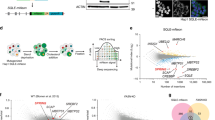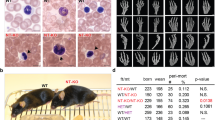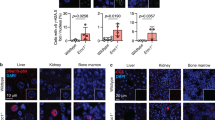Abstract
X-linked dominant disorders that are exclusively lethal prenatally in hemizygous males have been described in human and mouse1. None of the genes responsible has been isolated in either species. The bare patches (Bpa ) and striated (Str) mouse mutations were originally identified in female offspring of X-irradiated males2,3. Subsequently, additional independent alleles were described. We have previously mapped these X-linked dominant, male-lethal mutations to an overlapping region of 600 kb that is homologous to human Xq28 (ref. 4) and identified several candidate genes in this interval5. Here we report mutations in one of these genes, Nsdhl, encoding an NAD(P)H steroid dehydrogenase-like protein, in two independent Bpa and three independent Str alleles. Quantitative analysis of sterols from tissues of affected Bpa mice support a role for Nsdhl in cholesterol biosynthesis. Our results demonstrate that Bpa and Str are allelic mutations and identify the first mammalian locus associated with an X-linked dominant, male-lethal phenotype. They also expand the spectrum of phenotypes associated with abnormalities of cholesterol metabolism.
This is a preview of subscription content, access via your institution
Access options
Subscribe to this journal
Receive 12 print issues and online access
$209.00 per year
only $17.42 per issue
Buy this article
- Purchase on Springer Link
- Instant access to full article PDF
Prices may be subject to local taxes which are calculated during checkout




Similar content being viewed by others
References
Davisson, M.T. Review: X-linked genetic homologies between mouse and man. Genomics 1, 213–227 ( 1987).
Phillips, R.J.S. Striated, a new sex-linked gene in the house mouse. Genet. Res. 4, 151–153 ( 1963).
Phillips, R.J.S., Hawker, S.G. & Moseley H.J. Bare-patches, a new sex-linked gene in the mouse, associated with a high production of XO females. I. A preliminary report of breeding experiments. Genet. Res. 22, 91 -99 (1973).
Angel, T. et al. Genetic mapping of the X-linked dominant mutations striated ( Str) and bare patches (Bpa) to a 600-kb region of the mouse X chromosome: implications for mapping human disorders in Xq28. Mamm. Genome 4, 171–176 ( 1993).
Levin M.L. et al. A comparative transcription map of the murine bare patches [ Bpa] and striated [Str] critical regions and human Xq28. Genome Res. 6, 465–477 ( 1996).
Happle, R., Phillips, R.J.S., Roessner, A. & Junemann G. Homologous genes for X-linked chondrodysplasia punctata in man and mouse. Hum. Genet. 63, 24–27 (1983).
Chatterjee, A., Tanaka, T., Parrish, J.E. & Herman, G.E. Refined mapping of caltractin in human Xq28 and in the homologous region of the mouse X chromosome places the gene within the bare patches (Bpa) and striated (Str) critical regions. Mamm. Genome 6, 802–804 (1995).
Heiss, N.S., Rogner, U.C., Kioschis, P., Korn, B. & Poustka, A. Transcriptional mapping in a 700-kb region around the DXS52 locus in Xq28: isolation of six novel transcripts and a novel ATPase isoform [hPMCA5]. Genome Res. 6, 478–491 (1996).
Penning, T.M. Molecular endocrinology of hydroxysteroid dehydrogenases. Endocrine Rev. 18, 281–305 ( 1997).
Payne, A.H., Abbaszade, I.G., Clarke, T.R., Bain, P.A. & Park, C.J. The multiple murine 3β-hydroxysteroid dehydrogenase isoforms: structure, function, and tissue- and developmentally specific expression. Steroids 62, 169– 175 (1997).
Kelley, R.I. et al. Abnormal sterol metabolism in patients with Conradi-Hunermann-Happle syndrome and sporadic lethal chondrodysplasia punctata. Am. J. Med. Genet. 83, 213–219 (1999).
Gachotte, D., Barbuch, R., Gaylor, J., Nickel, E. & Bard, M. Characterization of the Saccharomyces cerevisiae ERG26 gene encoding the C-3 sterol dehydrogenase (C-4 decarboxylase) involved in sterol biosynthesis. Proc. Natl Acad. Sci. USA 95 , 13794–13799 (1998).
Schroepfer, G.J. Sterol biosynthesis. Annu. Rev. Biochem. 51, 555–585 (1982).
Clayton, P.T. Disorders of cholesterol biosynthesis. Arch. Dis. Child. 78, 185–189 (1998).
Farese, R.V. & Herz, J. Cholesterol metabolism and embryogenesis. Trends Genet. 14, 115– 120 (1998).
Tint, G.S. et al. –Defective cholesterol biosynthesis associated with the Smith-Lemli-Opitz syndrome. N. Engl. J. Med. 330 , 107–113 (1994).
Cunniff, C., Kratz, L.E., Moser, A., Natowicz, M.R. & Kelley, R.I. Clinical and biochemical spectrum of patients with RSH/Smith-Lemli-Opitz syndrome and abnormal cholesterol metabolism. Am. J. Med. Genet. 68, 263–269 (1997).
Kelley, R.I. RSH/Smith-Lemli-Opitz syndrome: mutations and metabolic morphogenesis. Am. J. Hum. Genet. 63, 322–326 (1998).
Fitzky, B.U. et al. Mutations in the Δ7-sterol reductase gene in patients with the Smith-Lemli-Opitz syndrome. Proc. Natl Acad. Sci. USA 95, 8181–8186 (1998).
Wassif, C.A. et al. Mutations in the human sterol Δ7-reductase gene at 11q12–13 cause Smith-Lemli-Opitz syndrome. Am. J. Hum. Genet. 63, 55–62 ( 1998).
Waterham, H.R. et al. Smith-Lemli-Opitz syndrome is caused by mutations in the 7-dehydrocholesterol reductase gene. Am. J. Hum. Genet. 63, 329 –338 (1998).
Johnson, R.L. & Scott, M.P. New players and puzzles in the hedgehog signaling pathway. Curr. Opin. Genet. Dev. 8, 450–456 (1998).
Reed, V. & Boyd, Y. RFLVs in mottled dappled alleles. Nature Genet. 8, 11–12 ( 1994).
Puck, J.M., Nussbaum, R.L., Smead, D.L. & Conley, M.E. X-linked severe combined immunodeficiency: localization within the region Xq13.1-q21.1 by linkage and deletion analysis. Am. J. Hum. Genet. 44, 724–730 ( 1989).
Hardison, R.C., Oeltjen, J. & Miller, W. Long/human-mouse sequence alignments reveal novel regulatory elements: a reason to sequence the mouse genome. Genome Res. 7, 959–966 (1997).
Ansari-Lari, M.A., Jones, S.N., Timms, K.M. & Gibbs, R.A. Improved ligation-anchored PCR strategy for identification of 5´ ends of transcripts. BioTechniques 21, 34–38 (1996).
Kelley, R.I. Diagnosis of Smith-Lemli-Opitz syndrome by gas chromatography/mass spectrometry of 7-dehydrocholesterol in plasma, amniotic fluid and cultured skin fibroblasts. Clin. Chim. Acta 236, 45– 58 (1995).
Gibson, K.M. et al. 3-Hydroxy-3-methylglutaryl coenzyme A reductase activity in cultured fibroblasts from patients with mevalonate kinase deficiency: differential response to lipid supplied by fetal bovine serum in tissue culture medium. J. Lipid Res. 31, 515– 521 (1990).
Antonarakis, S.E. et al. Update on nomenclature for human gene mutations. Hum. Mutat. 8, 1–6 ( 1996).
Bjorkhem, I. et al. Correlation between serum levels of some cholesterol precursors and activity of HMG-CoA reductase in human liver. J. Lipid Res. 28, 1137–1143 ( 1987).
Acknowledgements
We thank M. Platzer and A. Rosenthal for helpful discussions and for sharing human sequence data; M.B. Gilbert, D. Clarke, L.M. Mitchell, R.N.A. Straw and J.S. Greystrong for performing genomic sequencing of the mouse BAC and cosmid; J. Durbin and B. VanDyke for help with photography; and A. Payne for helpful discussions concerning 3β-HSDs. These studies were supported by NIH R01 NS34953 and Children's Hospital Research Foundation, The Ohio State University (G.E.H.) and R01 LM05110 from the National Library of Medicine (W.M.).
Author information
Authors and Affiliations
Corresponding author
Rights and permissions
About this article
Cite this article
Liu, X., Dangel, A., Kelley, R. et al. The gene mutated in bare patches and striated mice encodes a novel 3β-hydroxysteroid dehydrogenase. Nat Genet 22, 182–187 (1999). https://doi.org/10.1038/9700
Received:
Accepted:
Issue Date:
DOI: https://doi.org/10.1038/9700
This article is cited by
-
Statins repress hedgehog signaling in medulloblastoma with no bone toxicities
Oncogene (2021)
-
Crystal structures of human NSDHL and development of its novel inhibitor with the potential to suppress EGFR activity
Cellular and Molecular Life Sciences (2021)
-
Luteolin modulates gene expression related to steroidogenesis, apoptosis, and stress response in rat LC540 tumor Leydig cells
Cell Biology and Toxicology (2020)
-
Dietary supplementation with olive mill wastewaters induces modifications on chicken jejunum epithelial cell transcriptome and modulates jejunum morphology
BMC Genomics (2018)
-
Genomic copy number variation in Mus musculus
BMC Genomics (2015)



